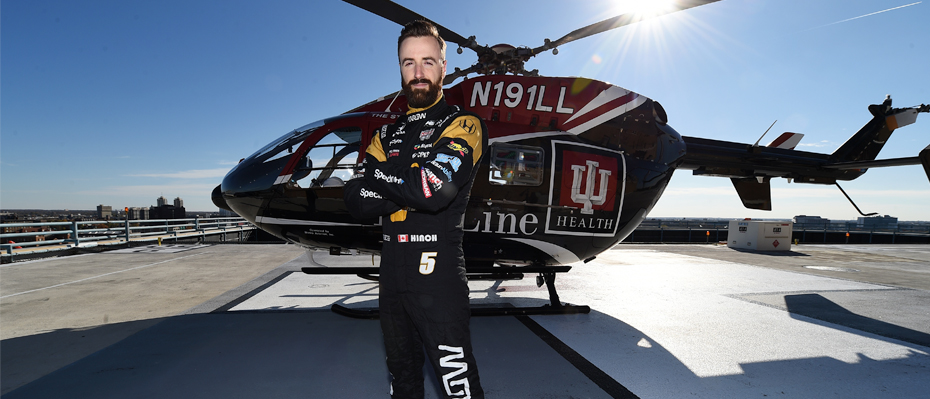James Hinchcliffe knows something about life-threatening bleeding, so the Verizon IndyCar Series driver was eager to help when asked to promote the national “Stop the Bleed” campaign.
That’s why the Schmidt Peterson Motorsports driver was recently on the helipad of IU Health Methodist Hospital in Indianapolis, along with members of the hospital’s trauma unit, demonstrating how simple it is to apply a tourniquet to oneself or someone else in dire bleeding situations.
“The goal is to educate people on tourniquet use, not only how easy it is but how important it is,” Hinchcliffe explained after demonstrating the simplicity of applying a Combat Application Tourniquet to himself. The CAT tourniquet, originally designed for military use, may be applied with one hand.
 “If you ever find yourself in a situation where there is severe bleeding, being able to apply a tourniquet either to yourself or to someone else can help to buy those precious minutes that it takes for an EMT (emergency medical technician) to arrive and ultimately save your life. It’s a super-simple device, it’s very easy to apply, whether to yourself or someone else, and it can make all the difference.”
“If you ever find yourself in a situation where there is severe bleeding, being able to apply a tourniquet either to yourself or to someone else can help to buy those precious minutes that it takes for an EMT (emergency medical technician) to arrive and ultimately save your life. It’s a super-simple device, it’s very easy to apply, whether to yourself or someone else, and it can make all the difference.”
Hinchcliffe sustained extensive blood loss when he crashed in practice for the 2015 Indianapolis 500 and a suspension piece pierced his pelvis. Only through the quick work of the Holmatro Safety Team at Indianapolis Motor Speedway, as well as physicians, nurses and staff at Methodist Hospital, did he survive.
“Blood loss was a big issue for me in my accident,” Hinchcliffe said. “It’s a big issue in trauma in general. On top of blood donation, which I’ve been a big supporter of, anything like this that can help stem bleeding and just buy EMTs that more time is a huge thing.”
Jill Castor, a nurse and the trauma program manager at Methodist, said there is a three-step process in halting bleeding following the initial 911 call for emergency help. First is compression on the wound for five to 10 minutes. If that doesn’t work and the bleeding is from an extremity, a tourniquet is next. The final step is packing the wound.
IU Health reports that bleeding is the No. 1 killer of injured patients. The Stop the Bleed initiative was launched in 2015 by the Department of Homeland Security. IU Health is underwriting its local program to train as many people as possible in learning how to apply tourniquets and encourage that all public facilities and as many private citizens as possible acquire tourniquets for use in an emergency. Castor said properly certified tourniquets may be purchased for $20-30.
“It’s very, very simple to apply,” Castor said. “It’s mostly Velcro. It’s one of those things that if you (practice) it a couple times, you’ll have it down pat. But at the end of the day, you can’t do it wrong as long as you stop the bleeding.
“The idea (of Stop the Bleed) is to get tourniquets and first-aid supplies that are needed to stop life-threatening bleeding in the hands of non-professionals,” she added. “So that in the case an event happens, someone can quickly apply devices such as the CAT tourniquet that we showed today.”
Since he was on the roof of Methodist at the time, Hinchcliffe couldn’t help but have a little fun as well. He hopped in the IU Health LifeLine helicopter and was taken for a ride around downtown Indianapolis. When the Canadian crashed at Indy in May 2015, he was transported to the hospital by ambulance in a time-saving effort.
“This makes up for it,” he joked as he climbed aboard.
